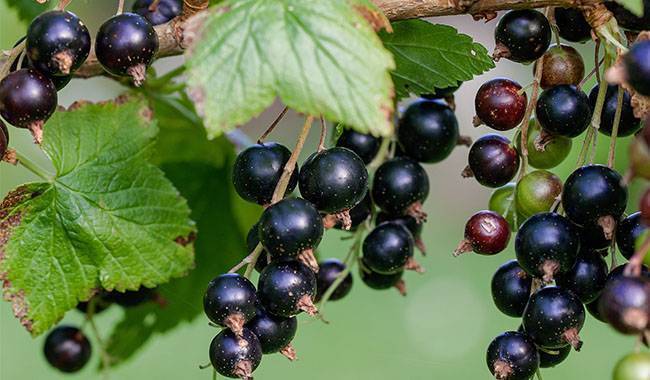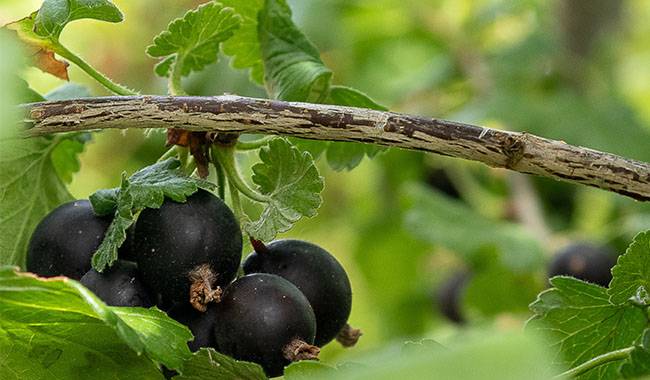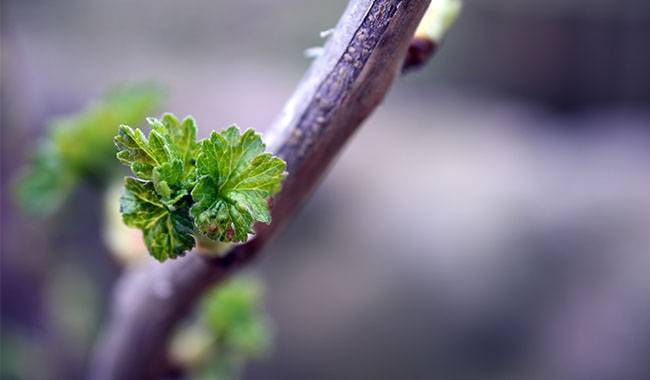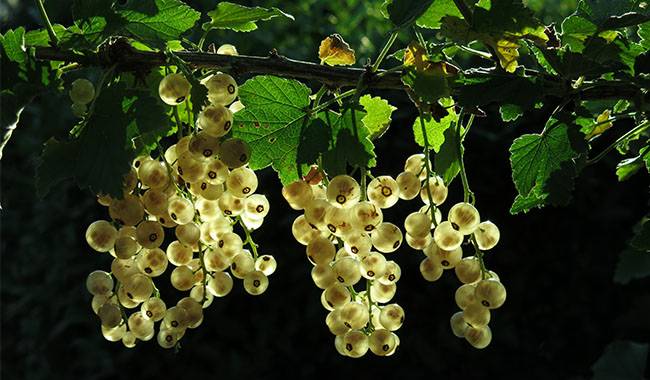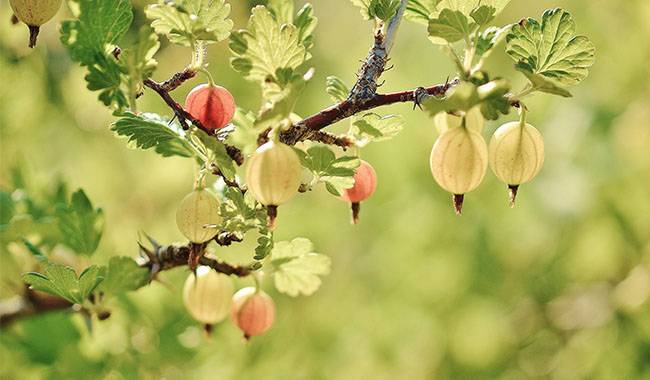
The great planters call Gooseberry bush the northern grape, not only because of its fruit’s resemblance to grapes but also because of the crop’s unpretentiousness and resistance to frost and drought. Biologically, Gooseberry is considered a relative of currants (very closely related) and belongs to the berry group of shrubs.
Gooseberry bush has a rich history, but it was unknown to the Romans and Greeks. As archaeologists assure, this is probably the reason why this plant has never been covered by myths and legends.
However, in Europe Gooseberry bush has been growing for quite a long time. In the whole continent, without exception.
HISTORY OF GOOSEBERRY
Not everyone knows that the first cultivated Gooseberry was obtained in France, reliable information about it dates back to the 13th century. The earliest and most detailed description of this thorny crop was given by Jean-Jean Roal, a French physician living in Paris around the beginning of the 16th century.
In his description, he mentions the color and flavor of Gooseberry and tells that the unripe fruit is used for making sauces and spices, while the fully ripe fruit appears beautifully in fresh form. He also mentioned that the noble people did not grow Gooseberry and rarely ate it because of the thorns on the shoots.
However, in those days, local doctors bestowed some magical powers on Gooseberry bush, for example, it was said to help pregnant women conceive and promote healthy fetal development.
In addition to France, Gooseberry is also successfully grown in England. It is worth noting that not only did the British love Gooseberry, but also the British climate, which is known to be characterized by warmth and high humidity; under these conditions, Gooseberry grew very well at that time, and its fruit quality was, at that time, the highest in this country.
The breeders of that time, often consisting of ordinary farmers, selected Gooseberry bush with large fruits, propagated them by dividing them, and gradually, through selection, achieved an almost fivefold increase in the quality of Gooseberry bush fruits within 60-70 years. Gooseberry was a major crop in England by the end of the 16th century when Gooseberry was only mentioned for the first time and was not considered an industrial plant. By the mid-17th century, the vast majority of Gooseberry varieties were selected by the English.
A little later, Gooseberry spread from France and England to Germany, and from there to the Netherlands and then to other countries.
In the United States, the history of Gooseberry has developed in parallel, with unconfirmed sources indicating that Gooseberry was grown in monastery gardens as early as the 11th century, and others saying that – Gooseberry first appeared in monastery gardens, but much later – in the early 18th century.
True or not, but Gooseberry was highly valued in America, known as the “fruit of life” and planted by hundreds of shrubs, each recorded under its own number in the corresponding journal. In one journal belonging to a certain estate owner, 80 Gooseberry bush were growing on his land and the color of each berry when it was fully ripe was written down.
The real popularity of Gooseberry came in the 19th century when huge plantations of this crop began to be laid everywhere. This was again caused by English breeders who introduced varieties with fruits several times larger than the largest fruits of the time. These varieties began to spread aggressively in the United States, and they replaced the obsolete cultivars of the time.
No one knows where Gooseberry would be now if powdery mildew had not accidentally arrived on the continent and exterminated Gooseberry from most of Europe. It is only recently that Gooseberry cultivars resistant to powdery mildew have become available and the Gooseberry culture is slowly beginning to recover and gain mass characteristics.
The demand for Gooseberry seedlings is growing, and no wonder, since this crop has a high nutritional value, is characterized by fast fruit set, stable and fairly high yields, its fruits can be stored for a long time (about a week) and can be transported long distances and harvested a few days before they are fully ripe.
Gooseberry can be eaten fresh or used in various processes. In this case, if the unripe berries are collected, they make a wonderful jam and the overripe berries. A wonderful jam, which is called royal, well, of course, ripe berries. What a wonderful healthy dessert.
Few people know that Gooseberry is not only delicious and healthy but also high in calories: 0.25 Gal (kg) of berries has more than 500 kcal, especially since the dessert variety has many colors and is characterized by high sugar content.
PROPAGATION OF GOOSEBERRY
Gooseberry planting material is best purchased in specialized nurseries, rather than in the hands, where you can be sold the completely wrong variety or even seedlings. By the way, you can learn to propagate Gooseberry yourself, especially since it is not difficult.
For example, one of the most common ways of asexual propagation of Gooseberry bush is to replicate the variety by horizontal plots. In order to implement this method, it is necessary to select the most developed shoots in early spring, bend them onto previously moist and loose soil before the buds open, and fix them using wooden or metal hooks.
Gooseberry shoots can be placed either in the soil or in a small recess 1.5-2inch (4-5 cm) deep.
Next, you need to wait for the growth to activate and the shoots to reach a height of 3-5inch (10-13 cm). After that, you can fill the Gooseberry bush halfway with loose soil, soak it, and water it. Later, it is important to keep the soil moist, as this will allow a well-developed root system to form on the shoots. Around mid-summer, when the shoots become twice as long, the pruning should be repeated to increase their height by a third.
In autumn, usually at the end of September or the beginning of October, the Gooseberry shoots should be “peeled” and separated from part of the root system of the mother plant, after which they can be planted in the soil and fixed.
It has been noticed that even with only a small amount of roots, a hair, Gooseberry shoots can root well in new places. The main thing is to reduce the above-ground part by half after planting these shoots.
Gooseberry bush can also be propagated well in the greenhouse by single and green cuttings. Not all varieties of Gooseberry bush have single cuttings that can be rooted.
In order to propagate these varieties of Gooseberry bush by rooting cuttings, it is necessary to cut them from a year’s length of 5-6inch (13-15 cm) in early September. Each plug should have about five live shoots on it.
Then the Gooseberry plugs should be planted in loose and nutritious soil, burying them in the ground so that only one bud appears on their surface. Planting scheme 3-5inch (10-13 cm) between cuttings and 20-22inch (50-55 cm) between rows.
Usually, in the spring Gooseberry bush starts to grow and form a root system. In order to obtain mature seedlings, it is necessary to water the soil during this season, not to allow it to dry out, to loosen the soil, not to allow the formation of soil slabs, and to fertilize.
By the way, fertilizer must be two – in early spring and midsummer, about 30-35 grams of nitroaminophoska per 11 square feet of soil. In the fall, the already prepared Gooseberry seedlings can be dug up and planted in a new place.
Other Gooseberry varieties can be propagated by green cuttings. Cut them in early summer to a length of 5-6inch (13-15 cm), remove all but a few upper leaves from the cuttings, and plant them in a greenhouse, covered with cling film, in a mixture of low-lying peat, mulch, and river sand, sunk to 0.8-1.2inch (2-3 cm).
With regular watering – 5-6 times a day in hot weather and 3-4 times a day in cloudy weather – by autumn the Gooseberry plugs will have formed a root system and can actually be planted in a permanent place as individual seedlings.
HOW TO GROW GOOSEBERRY BUSH?
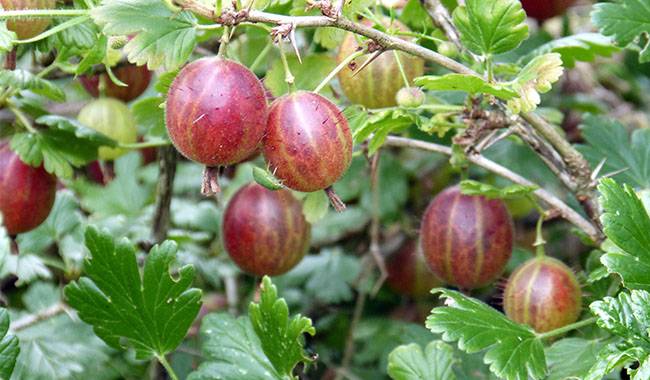
So, whether you receive Gooseberry seedlings independently or buy them in a nursery, in order to get a good crop it is important to choose the right place, plant the seedlings correctly and take proper care of them.
By the way, planting of Gooseberry bush can be started in autumn and spring. In this case, autumn is the most suitable time, because it is usually warm and there is enough moisture in the soil. In spring, you are unlikely to have time to plant before the buds open, and planting plants that have already awakened does not bode well.
The choice of a place to plant Gooseberry bush should always take into account cultural peculiarities. Thus, it is noted that Gooseberry bush grows better on loose and nutrient-rich soil and is afraid of weeds, especially – wheatgrass.
Considering this, Gooseberry should be planted on open, well-lit plots without any shade, with loose and nutrient-rich soil (black, yellow, sandy, gray forest soil) and a water table not exceeding 60inch (1.5 meters).
On the north side, it is best to protect it from cold winds with house walls, fences, or thick-crowned shrubs.
The seedbed in which Gooseberry is planted should be flat and free of depressions; it should not accumulate any meltwater or rainwater, although the soil should be moderately moist and not too dry.
Before planting Gooseberry bush, it is important to prepare the soil well; to do this, you must dig the soil with the full bayonet of a shovel, making sure to remove as many weeds as possible, especially the roots of the couch grass, loosen the soil and make it level.
If your plot has poor soil, add 1-1.3 Gal (4-5 kg) of well-decomposed manure or humus, 500-600 g of wood ash, and a tablespoon of nitrocellulose for every 11 square feet under the excavation. Only after this, you can do the actual planting.
By the way, in order for Gooseberry seedlings to turn into fully developed plants in the future, it is necessary to choose the best option for placing them on your plot. For example, between rows, if you want to plant Gooseberry, you need to leave a free space of 80inch (2 meters) between rows of plants (or just between seedlings) – about 40inch (1 meter).
It is not recommended to put Gooseberry bush plants closer together, they will interfere with each other and it will be difficult to take care of them, handle the soil and collect the harvest considering the spines of the plants.
After you have decided on a plan for planting Gooseberry, you can immediately start digging planting holes. The size of the hole depends directly on how well the root system of the Gooseberry seedling develops.
Therefore, if you plant annuals, in fact – rooted cuttings or clover – there is no need to dig a large hole; a small hole of 7-8inch (18-20 cm) depth and 4-6inch (10-15 cm) width will suffice.
When planting biennials with well-developed root systems, a hole 10-12inch (25-30 cm) deep and 12-14inch (30-35 cm) wide is usually required.
Place a drainage layer, either crushed brick or expanded clay, about 1 inch thick at the bottom of the hole, and top it with a nutrient layer: a mixture of soil and humus in equal proportions. Next, still watering the bottom of the hole, pour a bucket of water and set the roots of the seedlings on this mixture, tidying up the root system nicely. Then, the roots of the Gooseberry bush should be covered with soil, place the seedlings so that their root necks are submerged in the ground for about 1 inch, compact the soil well, water the seedlings with a bucket of water, and cover the surface with peat or humus, a layer of about 1 inch thick.
After planting, you can shorten the above-ground part of the Gooseberry bush seedling by about one-third, which will enhance its future branching ability.
HOW DO I CARE FOR GOOSEBERRY?
Next comes care, including pruning, fertilizing, watering, and preventing pests and diseases.
Pruning of Gooseberry: Usually in the first year trying to leave the three most developed shoots (after shortening). the remaining shoots of Gooseberry are usually cut off, although it is quite possible not to do so.
In the spring of the second year, three shoots can be left again from the young Gooseberry shoots, if they will go from the roots, after a year – leave three more and regulate this number in the future, slowly replacing the old shoots with new ones. All Gooseberry bush that is too close to the soil or grows deep into the canopy should ideally be cut back.
From the sixth or seventh year of the seedling, you can simply remove old buds, broken, dried out, and those that thicken the canopy.
Watering: Gooseberry cultivation is drought tolerant, but if it lacks water, it will be difficult to obtain a good crop. Watering is necessary and particularly important during the flowering period (usually in early May) as well as during ovary formation and harvest maturity. At this time, a bucket of water should be applied weekly under each Gooseberry bush, unless, of course, it is raining and the weather is very hot.
Watering can be combined with fertilization. The best program is as follows: first, remove all weeds from the Gooseberry bush, then loosen the soil, fertilize, water, and cover with a 0.8-1.2inch (2-3 cm) thick layer of humus.
You should fertilize the soil three times during the season, in spring with a nitrate phosphate fertilizer and a tablespoon of fertilizer under each bush, in early June you should fertilize each bush with wood ash – 150-200 grams (under each plant) and in July with a teaspoon of calcium superphosphate and potash under each plant.
Gooseberry bush responds very well to the introduction of organic fertilizers. This is best done in the spring, alternating throughout the year. For plants less than 5 years old, 1.3-1.6 Gal (5-6 kg) of organic fertilizer under each bush is sufficient, for older plants the dose can be doubled.
When applying liquid organic fertilizer, do not forget to dilute it with water: for example, cow manure is usually diluted six times, chicken manure ten times, and manure seven times. No more than one bucket of such fertilizer is appropriate under each Gooseberry bush, starting with a good loosening of the soil.
An important part of the care is the fight against diseases and pests. a rather dangerous disease of Gooseberry is anthracnose. It is important to fight against rot in the fall to eliminate possible or already visible sources of infection. To do this, all shoots affected by anthracnose should be cut back and fallen leaves showing signs of anthracnose should be collected and burned. The soil under the bushes should be sufficiently loosened.
In the spring, the fight against the infection must continue. To combat anthracnose, there are several safe and fairly reliable folk control measures. For example, a fairly common technique is to sprinkle the Gooseberry bush with water heated to 140°F (60°C). Such water cools as it is splashed and will not destroy the leaf layer or shoots, but will kill the source of infection.
Spraying cowpeas every two weeks will also help control anthracnose. Dilute cowpeas in seven times as much water (1:7). By treating the fermented mud, pre-diluting half of the first treatment, and then diluting it 2-4 times, you can get uncommon results.
The treatment of infusion of field sedge can also be used to control the disease. To do this, you need to take about 1 Gal (4 kg) of thistle leaves and their stems, crush them, put them in a container, and pour them in a bucket of water. Then you need to let the solution soak for 10 hours and you can use it, treating the diseased plants three to four times, at intervals of one week.
As for pests, the Gooseberry bush is periodically attacked by aphids that twist the tips of the leaf plates and cause fresh plants to deform. Aphids can also be treated with traditional methods such as treating plants with an onion peel soak, which involves putting 150-180 grams of onion peel into a bucket of water at room temperature and letting it sit for five hours.
Spraying with bitter pepper helps: add 300 grams of bitter pepper pods to 0.8-1 Gal (3-4 liters) of water and leave for 6-7 hours. If aphids are rare, they can be collected by hand along with the leaves and destroyed.
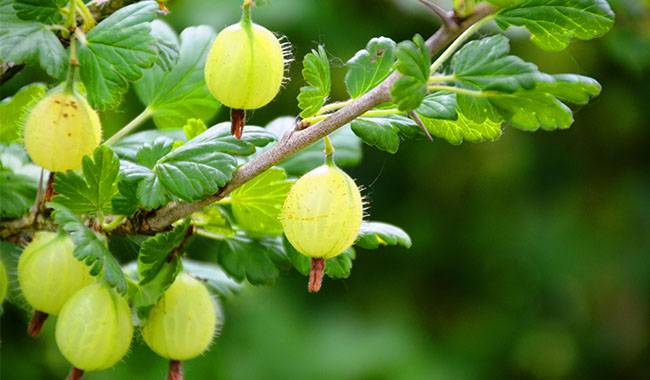
HOW TO HARVEST GOOSEBERRY?
In fact, that’s all you need to know in order to get a good Gooseberry crop. All that remains is to harvest it. Given that the bush has thorns, you need to be careful and know that the berries ripen at different times, you can wait for them to ripen in large quantities and collect them in one, or at most two, receptions.
If you need to store or transport the berries, you can pick slightly immature berries, if not necessary, it is better to wait for the full ripeness level.
More related information about growing Gooseberry plants




